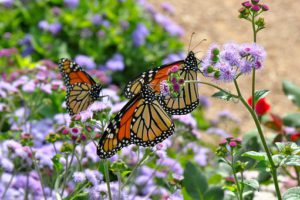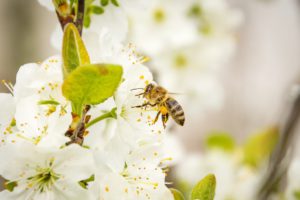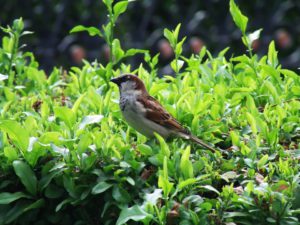Let’s talk about the birds, the bees, and the butterflies

Wildlife gardening has become so popular among home gardens because of the many benefits these garden types bring, Constructing a wildlife garden does not only beautify but helps in bringing balance to our ecosystem.
What I love about wildlife gardening is the amount of activity which can be found within these gardens, how good it is to take a walk in your garden and to see birds resting, taking a drink or grabbing a meal, or what about butterflies flying so gracefully from plant to plant with their wings in such beautiful display of colors.
Then there are bees which are very busy workers moving from plant to plant doing what they do best in helping our garden plants along the way so we can reap a good harvest, with all of this activity and excitement taking place who wouldn’t want a garden of this sort?
I have written separate articles on gardening for butterflies, birds, and bees but in this article, we will be combining the three to see how this works so if you are interested in a combination garden which is also known as biodiversity then stick around as we take a closer look into the wonderful world of wildlife gardening. For more on wildlife, gardening go to the category section of this website.
Native plants to attract wildlife
One important factor to consider when planning to construct a wildlife garden is the choice of plants, without the right choice of plants, you won’t have much success. Native plants are important so when it comes to constructing a garden go native for success.
Native plants are cost-effective and will also attract beneficial insects that will help to protect plant life so again as I mention go native.
Other components
We will also be looking at other components that are needed in these garden types bringing them together to create a garden paradise.
Constructing a butterfly garden
When constructing a butterfly garden do not only use plants that are native but plants that will attract butterflies so learn the butterflies in your area and which plants attract them then check with your local plant nursery for these plant types.
Providing a water source for your butterfly garden
Adding water to a shallow bowl or two and placing them in your butterfly garden will supply them with all the water they need.
Flat rocks
You will need to provide resting places for butterflies to rest like a few flat rocks. Remember the goal here is to make the garden as natural and as inviting for our butterfly friends.
Create a puddle station
All this entails is simply using a large shallow bowl, fill the bowl with sand, and add water to the bowl. The sand must be moist at all times, add two tablespoons of compost, chicken manure, stale beer also add a few stones where the butterfly can sunbathe. This puddle station is not only for the butterfly to sunbathe but as the male butterfly drinks this water it will encourage them to mate. It is a butterfly love potion.
Next comes the Bees

Adding components to attract bees
To keep your wildlife garden flowing you must make accommodation for bees also which includes
- Installing bee boxes. These boxes are square about 15-26 inches in diameter. With 2 holes for ventilation, covering the ventilation with a netting material will keep insects such as ants out.
- These boxes also have entrance and exit holes for bees. Also, cover the boxes with a material that will keep the nest dry
- Install flowering plants in clusters
- Plant flowering fruits
- Plant flowers that grow in sequence
- Plant flowering vegetables
- The use of herbs that attract bees such as sage, lemon balm, basil, lavender, and chives
- Provide a dump or muddy area with water for bees to drink
- Installing dry grasses along with a small brush pile and deadwood would make an ideal spot for a bees habitat
Now we move on to the birds
Native Plants
When it comes to the birds it is best to see which birds are in your area, do a little research to see which plants attract thems. Check with your garden nursery to see if they carry those plants and learn how to install and care for them.
A Birdbath

What you also want to do is install a birdbath which will provide a place for your feather friends to bathe and get a drink of water when ready.
A bird feeder
Installing a bird feeder will have your guest buzzing with excitement, the bird feeder should be placed in and area that is secure from cats, dogs, and other predators. A great place to install a bird feeder is in and an area where it is out of reach like high in a tree.
Additional Information for your wildlife garden
1. Never use harmful chemicals in a wildlife garden which can have an adverse effect on wildlife and beneficial insects.
2. The use of natural predators such as beneficial insects which are also known as biological control is the best choice.
3. Ensure that your garden is kept as clean as possible remove all debris.
4. Regular check your plants to ensure they are free of disease.
5. Use products that are safe around humans and pets when treating for disease.
6. Weeds will encourage garden insect pests and disease so keep your garden as weed-free as possible.
7. Keep all of your garden tools in good repair by regularly cleaning them and keep them well oiled.
8. Prune diseased plant parts and thoroughly discard.
9. Try to keep your dogs and cats out of these areas.
10. To make your wildlife garden more enjoyable and relaxing why not add a few garden furniture where both you and your family can sit and enjoy your wildlife garden.
11. Healthy plant material that is pruned can be set aside to start a compost pile.
12. When working in your garden especially during the summer months the use of long sleeves shirts, pants, and a hat along with quality heavy-duty garden gloves is a must, wear the proper footwear and if you must use sunscreen then, by all means, go ahead.
13. Drink enough water and rest in the shade from time to time.
14. Carrying your tools in a wheel burrow is a great way to make your job easier.
15. Have a first aid kit close by just in case you need it.
16. If the project is too big for you then get help.
17. Before starting your day in the garden make sure to eat a good breakfast.
18. Keeping pruning tools on hand such as hand pruners, loppers, and hedge shears will help in maintaining your garden plants giving that all clean-natural look.
19. It is a good choice to use organics especially on edible plants but if using synthetic or man-made fertilizers read and follow the manufacture’s label.
20. When watering your garden plants ensure to water at the ground level because water that is splashed on the leaves can encourage disease.
The final word
A combination garden like this may seem to be a lot of work but the good news is these gardens are worth the effect the key is to have fun and the goal is to beautify while bringing balance to the ecosystem so go for it you will love the results as your garden comes to life watching the many wildlife in their natural habitat.
About the author
Norman loves being in the garden, both at home and for his job....
he is 'Natures Little helper' being outdoors, growing his vegetables and flowers from an early age.
Now having spent over 22 years in the profession he want to give some of his knowledge to others...
his vast array of hints and tips you will find scattered over this site will help you no end growing plants in your garden.

Hi Norman,
It’s always a pleasure to read your posts.
I didn’t know there was wildlife gardening at all! But now I know and I like it. I’m actually imagining how pleasant it’d be to have a successful wildlife garden with frequenting butterflies of all colors and sizes, and the buzz of the honey makers, plus the chirp heroes of every morning. Awesome.
I’ve learned that to succeed in wildlife gardening, I need to take care of the habitat and make it as natural as possible. The Butterflies would need flat rocks for landing/resting, the bees would need small hives, and the birds a birdbath and feeder.
Thanks for this crucial information.
Boniface- AndroidBix
These gardens are really amazing and so much fun. So happy to help and please let me know how it goes.
It’s really true that wildlife planting has gained ground overtime, my dad has a garden that mostly accommodates bees, since his young age, he’s been into bee keeping and he knows quite a lot about it, don’t blame me that I couldn’t learn from him cos I don’t really like it, I prefer keeping a normal flower garden. Anyways, it’s very nice to have this and I think considering gardening for wildlife will be a good idea. The only question I have now is, what kind of environment is best for such activity as wildlife gardening??? To some extent, it’s kind of dangerous to keep these birds, or rather animals too close to where human stays, so please I’d so much love to hear your take on this.
These gardens are really amazing, remember wildlife will only react if they feel threatened. Having a wildlife garden is like going on a nature walk the only difference is that this nature enclosure is in your backyard. If you are still not sure then what you should do is to research information about birds in your area so you can learn about them. Butterflies are harmless and peaceful while bees will sting if felt threatened so keep this in mind and you will be ok. Please let me know how it goes and all the best to you.
I would really love to have a butterfly garden. This is really in depth information on how to go about it. I would have never thought of flat rocks for the butterflies to rest. The puddle creation process sounds very easy to implement. Glad that all the materials I will need for this project are easily available. Birds would also be great to have. I see them coming frequently because of the grains we drop. I will be implementing these steps to have them on a permanent basis. Great informational article!
Having a wildlife garden is really amazing and will provide so much fun as we watch our garden friends in their natural habitat. So happy to help and please let me know how it goes, all the best to you and have a good day.
Hello Norman,
Wildlife gardens never fails to relax our mind and body. Even though I personally don’t have a big wildlife garden where bees and birds roam freely, I love to spend my time watching butterflies and colorful flowers. So I am definitely going to read your article about butterfly garden in the future. All the additional informations you have given at the end every helpful. It’s good thing to be reminded about not using harmful chemicals, keeping away cats and dogs from the garden and discarding prune diseased plants immediately. Thank you very much for writing this informative article about wildlife gardening Norman.
Wildlife gardens are really amazing with all the activities that go on as we watched nature this is so relaxing. I am so happy to help, all the best to you and have a good day.
Gardening for butterflies and birds is pretty interesting even though I’ve never had that in mind before l, I’m a kind of flowers person and I’ve been into it for a very long time. I’d love to engage in this kind of gardening but there’s on major concern I have and its the fact that these wildlife can go outrageous and they can keep coming on massive amount, how can this be controlled without having to destroy the plants??
You have asked a very good question when we look at nature remember that nature has a way of bringing balance this is what makes our ecosystem so amazing. The food chain has to be taken care of and that’s what makes for a good ecosystem. Your wildlife friends may also feed on each other which is the cycle of life sorry for putting it that way. All the best to you and have a good day.